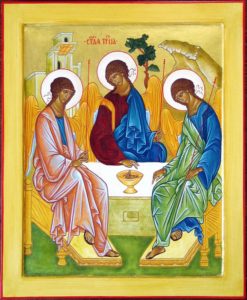Gracious God, take our minds and think through them;
take our hands and work through them;
take our hearts and set them on fire.
Amen.
Father, Son, Holy Spirit.
Creator, Redeemer, Sustainer.
The Holy Trinity.
A theological issue that took many years and many arguments to solidify as church doctrine. One of the hallmarks of our faith as Christians. And one of the hardest things for us to define.
What does it mean, really, that these three divine persons coexist in unity as co-equal, co-eternal and consubstantial – that is, of one being? Is it any wonder that while there are countless ways of describing the relationship between the persons of the trinity, it is still considered a mystery of Christian faith? And so, how do you engage a mystery?
The most enduring image of the trinity is surely the icon written by Andrei Rublev, in which he interprets the Trinity as the three mysterious visitors to Abraham and Sarah described in Genesis 18.
Everyone should have received a print out of this icon when you picked up your bulletin – if you don’t have one please share with your neighbor.
The three visitors in this icon are depicted as angels, signifying they belong to heaven rather than earth. They are sitting around three sides of a table. Their faces are essentially identical, representing the equality of the three persons of the Holy Trinity. Rublev presents them as gender neutral – and if you look, you will see faces and hair that could be considered feminine, and yet bodies, hands and feet that are distinctly masculine – a mix that comes across as beautiful and otherworldly rather than strange or disjointed.
The angel on the left (Father/Creator) is wearing a cloak of an indefinite hue, pale pink with brown and blue-green highlights, symbolic of the impossibility of portraying God in visible form. Above this angel is a building, symbolic of the Church and worship of God.
The angel in the center (Son/Redeemer) is wearing a dark reddish purple tunic and a dark blue cloak, which are the customary garments for Christ in most icons. The color of the tunic is symbolic of Christ’s human blood and his royal status. The blue signifies the mystery of his divine nature. Above this angel is a tree, the Oak of Mamre mentioned in the Genesis account of the three visitors, but also symbolic of Christ’s crucifixion and the wood of the cross.
The angel on the right (Holy Spirit/Sustainer) is dressed in a green cloak, traditionally the color of life and renewal, and a blue tunic of divine mystery. Above this angel is a mountain, symbolic of the spiritual journey or spiritual ascent toward salvation.
And on the table, between the figures, is a dish containing the meat Abraham prepared for his guests. It rests at the focus of the circular arrangement of the angels as a symbol of the Holy Eucharist, the continuing renewal of the Covenant between God and humanity.
All in all, it is a beautiful image, one that draws you in whether you know all of those details or not – because you don’t have to know all of that to know that the icon is incomplete. There is an open spot at this table, a place for a fourth person to sit down. And we – each of us – are invited to sit there.
God loves us and wants to be in relationship with us. This is what we can take away from our reading in Genesis today. The point is not that God created the world, but why God created the world. The answer being that God loves humans. This is clear, as we are the only ones out of all of creation that are made in God’s image, and we are given stewardship over everything else created. Male and female, we are God’s image bearers. We are icons. And God wants us to sit at the table, to share conversation and a meal, to be a part of the divine love that binds the three-in-one together.
Yet just as surely as we are called into relationship with God, we are sent out into the world.
Our Gospel tells us today that the disciples went to the mountain to which Jesus directed them, and from there they were sent to make disciples of all the nations, baptizing them in the name of the Father and of the Son and of the Holy Spirit, and to teach about God’s great commandment to love one another.
This is our call too. It is not enough for us to only take our seat at the table. We must go forth and keep the promises made in baptism, and in so doing transform the world.
May we always answer the call both to sit at the table and go forth into the world. And in the words of Paul, “The grace of the Lord Jesus Christ, the love of God, and the communion of the Holy Spirit be with all of you.”
~ AMEN ~


